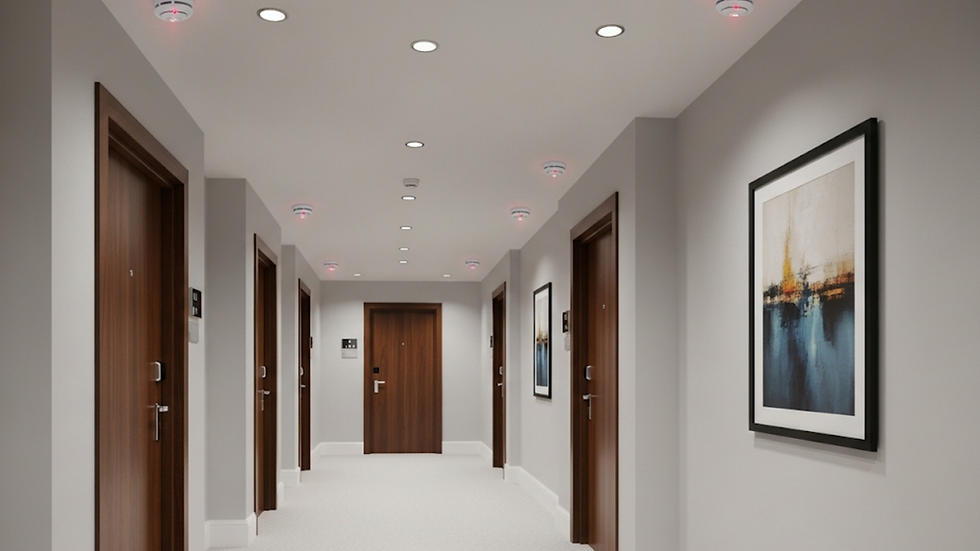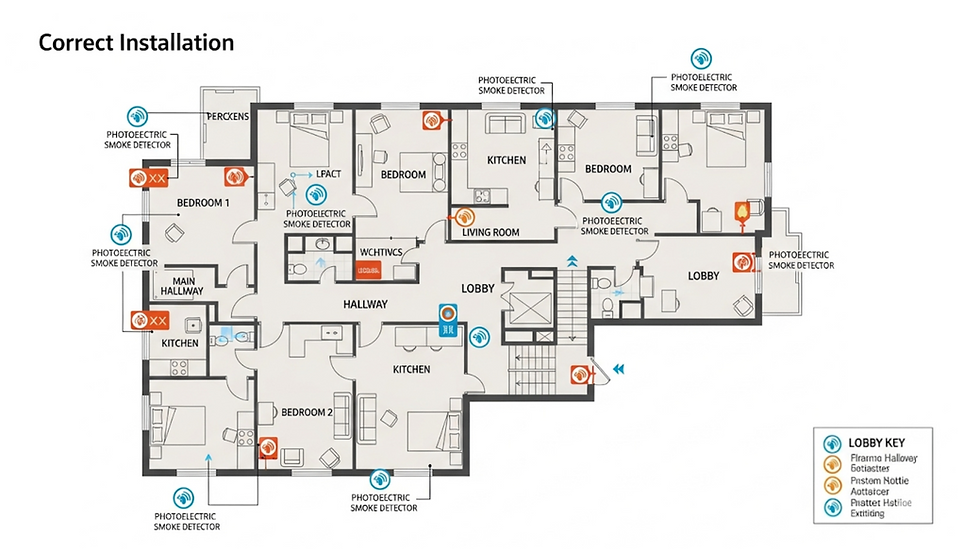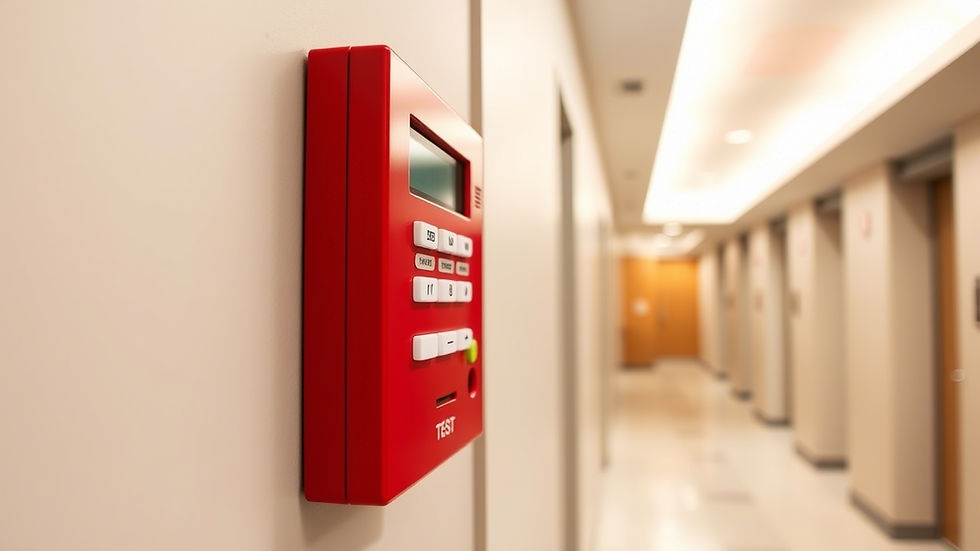The Best Photoelectric Smoke Detector Options for Multi-Unit Residential Projects
- Quickship Fire
- 4 minutes ago
- 4 min read
Introduction
When you think about fire safety in big residential projects like apartments or condos, smoke detectors are one of the first things come in mind. And not just any detector, but the right type. A Photoelectric Smoke Detector is often the better choice for multi-unit buildings because it can pick up on smoldering fires that produce more smoke than flames in the beginning. In places where people live close together, those few extra minutes of warning can literally save lives.
In this guide, we’ll go through why these detectors matter, how they compare with others, what features to look for, and also a few extra considerations like when you might need a duct detector or a duct smoke detector in larger projects.

Why Photoelectric Smoke Detectors Matter in Multi-Unit Buildings
Fires in apartment complexes don’t always start as big flames. More often, they begin as slow burning situations, like a cigarette on a sofa cushion, or faulty wiring in the wall. A Photoelectric Smoke Detector uses a light sensor that gets disrupted when smoke particles are in the air, which makes it way more sensitive to this type of fire than an ionization detector.
For multi-unit projects, that means early alerts for residents before the fire spreads. These detectors reduce nuisance alarms from cooking too, which is another big plus when you’re installing them in dozens or even hundreds of apartments.
Key Features to Look For
When you’re choosing detectors for large buildings, it’s not just about picking any model. Here are features you’ll want to keep an eye on:
Interconnectivity
Multi-unit residential setups usually need all detectors to talk to each other or to a central system. If one unit goes off, others should follow to warn everybody in time.
Power Source
Hardwired with backup batteries – Most reliable for bigger projects.
Battery-only – Easier to install but not ideal for compliance in large complexes.
Compliance Standards
Look for models tested by UL (Underwriters Laboratories) and follow NFPA 72 fire safety code. This makes sure you don’t run into issues with inspectors down the line.
Reduced False Alarms
One of the biggest complaints in apartments is false alarms from cooking. A good Photoelectric Smoke Detector will have features that limit that without compromising safety.
Where Duct Detectors Fit In
In larger residential projects, especially with shared HVAC systems, you might also need a duct detector or a duct smoke detector. These are installed directly in ventilation ducts. Their job is to spot smoke traveling through the air system and shut down fans so smoke doesn’t spread from one unit to another. They’re not replacements for individual unit alarms but they add a big layer of protection in bigger complexes.

Top Uses of Photoelectric Smoke Detectors in Residential Projects
Here’s where they shine most:
Apartments and Condominiums: Common in bedrooms, hallways, and shared areas.
Senior Living Facilities: Extra response time is crucial for elderly residents.
Student Housing: Dorms and apartments for students need reliable detectors because of the higher risk of accidents.
High-Rise Buildings: Longer evacuation times mean early detection is critical.
Buying Guide: Choosing the Best Options
Here’s a simple checklist to guide your buying decision:
Make sure the detector is UL listed.
Look for interconnect or wireless network capability.
Consider smart features (app alerts, remote monitoring).
Always check your local building code before buying in bulk.
Think about how these detectors integrate with other systems like sprinklers and duct smoke detectors.
Pro tip: Don’t just go for the cheapest option. Over the long term, reliability and compliance will save you money and headaches.
Installation Tips
Place detectors inside every bedroom, outside sleeping areas, and on every floor of the building.
Don’t install too close to kitchens or bathrooms where steam or cooking might cause false alarms.
For hallways and shared spaces, go with interconnected detectors so alerts spread fast.
In buildings with central HVAC, don’t skip on duct detectors as they prevent smoke circulation through vents.

Maintenance and Replacement
Just installing detectors isn’t enough. They need regular care:
Test alarms once a month.
Change batteries at least once a year, or sooner if the unit chirps low battery.
Clean detectors with a vacuum to keep dust from interfering with sensors.
Replace every 8–10 years because sensors lose sensitivity over time.
Conclusion
The Photoelectric Smoke Detector is one of the smartest investments you can make for multi-unit residential projects. They are reliable, reduce false alarms, and most importantly, they save lives by giving early warning in smoke-heavy fires. Pair them with duct smoke detectors for HVAC protection, and you’ve got a safety system that meets code and gives peace of mind.
Whether you’re a builder, property manager, or homeowner’s association, the right choice of detectors will keep your residents safe and your property up to standards.
FAQs
Q1. Why choose a Photoelectric Smoke Detector over other types?
A Photoelectric Smoke Detector is better at detecting smoldering fires, which are more common in apartments. Ionization detectors respond faster to flaming fires, but they also give more false alarms from cooking. In multi-unit residential projects, photoelectric is usually the recommended option.
Q2. Can I use one type of detector for the whole building?
Yes, many buildings standardize with photoelectric detectors because they meet compliance and reduce false alarms. But some codes ask for a mix of detectors, so always check local requirements.
Q3. Where do duct detectors come into play?
Duct detectors or duct smoke detectors are installed in HVAC systems. They don’t replace room detectors but stop smoke from spreading through vents, which is very important in high-rise and large complexes.
Q4. How often should detectors be replaced?
Most manufacturers recommend replacement every 8–10 years. Even if they still beep during tests, the internal sensor may not work correctly after that time.
Q5. How can I reduce false alarms in apartments?
Choose a Photoelectric Smoke Detector with nuisance alarm resistance. Also, avoid placing them too close to kitchens or bathrooms. Interconnected systems can help warn residents without being overly sensitive in one area.
Q6. Are there smart options available?
Yes, many new photoelectric detectors come with Wi-Fi or app integration. For property managers, this means you can monitor units remotely and get alerts directly on your phone if an alarm goes off.



Comments